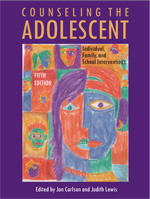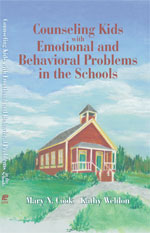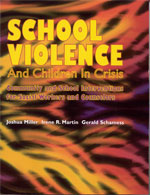 |
| >COUNSELING KIDS WITH EMOTIONAL AND BEHAVIORAL PROBLEMS IN THE SCHOOLS |
|
Mary N. Cook and Kathy Weldon
Counseling Kids With Emotional and Behavioral Problems in the Schools is a comprehensive text on counseling in a user-friendly format that makes it a joy for those who work with children with emotional and behavioral problems.
Cook and Weldon explore different emotional and behavioral problems and the children who exhibit them, including children who are depressed, unsafe, socially impaired, anxious, selectively mute, school-refusing, disruptive or ADHD, and difficult. The book also examines working with classes or groups, as well as crisis intervention from the counselor’s perspective.
Categorized by emotional or behavioral difficulty, each chapter dissects the epidemiology and major characteristics of the problem, assessment techniques, and interventions. The text relates countless scenarios, dialogues, and case studies and provides activities, games, and sample behavioral contracts to be used by counselors, teachers, and parents.
Special Features
- Provides essential information and statistics about each emotional or behavioral problem
- Emphasizes practical and usable strategies to effect change in children
- Includes three appendices with more than 40 blackline masters to be used around the office, classroom, or home
Contents
- The Depressed Child: What to Do With Kids Who Are Sad
- The Unsafe Child: What to Do With Kids Who Threaten to Harm Themselves or Others
- The Socially Impaired Child: What to Do With Kids Who Can’t Get Along With Others
- The Anxious Child: What to Do With Kids Who Worry Too Much
- The Selectively Mute Child: What to Do With Kids Who Won’t Talk at School
- The School-Refusing Child: What to Do When Kids Won’t Go to School
- The Disruptive or ADHD Child: What to Do When Kids Won’t Sit Still and Be Quiet
- The Difficult Child: What to Do When You’ve Tried Everything
- Working With Groups or Classes: How To Intervene With More Than One Child
- Crisis Intervention: How to Intervene in the Face of Tragedy
- Appendix A: Techniques for Counseling Socially Impaired Children
- Appendix B: Techniques for Counseling Anxious Children
- Appendix C: Techniques for Counseling Disruptive Children
- Appendix D: Sample Behavioral Contracts
0501/176 pages/2006
Paperback
ISBN 978-0-89108-313-9
$32.00
|
|
|
|
|
 |
| >TEACHING SOCIAL-EMOTIONAL SKILLS AT SCHOOL AND HOME |
|
Linda K. Elksnin and Nick Elksnin
Teaching Social–Emotional Skills at School and Home is designed to provide teachers and parents with strategies for teaching children and youth to become socially and emotionally competent.
This book is research-based yet practical and easy to read. The authors examine all aspects of social–emotional learning, including emotional literacy, social problem solving, and the social skills essential for making friends and succeeding in school—making this text the most comprehensive available.
Readers will learn how to teach social–emotional skills at the individual, classroom, schoolwide, and districtwide levels by integrating instruction within the academic curriculum and how to make social–emotional learning part of school and family life.
Special Features
- Includes assessment approaches to identify children who need social–emotional skills instruction
- Contains practical activities to help children of all ages understand and regulate emotions, make and keep friends, solve social problems, and succeed in school
- Addresses the importance of social–emotional skills for gaining and maintaining employment
- Incorporates real-life vignettes that connect theory and practice
- Provides numerous useful forms, checklists, and planning sheets
Contents
- The Importance of Social–Emotional Competence
- Identifying Children and Youth Who Need Social–Emotional Skills Instruction
- Teaching Children and Youth to Understand and Regulate Emotions
- Teaching Children and Youth Social–Emotional Problem-Solving Strategies
- Teaching Children and Youth Peer-Pleasing Social–Emotional Skills
- Teaching Children and Youth Teacher-Pleasing Social–Emotional Skills
- Teaching Occupational Social–Emotional Skills
- Parents as Teachers
- Getting Children and Youth to Use Social–Emotional Skills
- Appendix A: Books for Parents, Children & Youth, and Teachers & Administrators
- Appendix B: Children’s Books Chosen by Children
0603/352 pages/2006
Paperback
ISBN 978-0-89108-316-0
$60.00
|
|
|
|
|
 |
| >COUNSELING CHILDREN AND ADOLESCENTS • Fourth Edition |
| Ann Vernon
This new edition has been revised considerably to include even more practical information and “how to” strategies for counseling children and adolescents, as well as for working with families and parents. The authors present numerous empirically based approaches that are developmentally and culturally appropriate for counseling children.
This text offers helpful information on the individual and group counseling process and includes a plan for designing a developmental counseling curriculum from primary grades through high school. Comprehensive, up-to-date chapters specifically address counseling children who are at risk or who have special needs and children and adolescents from diverse backgrounds. Chapters on play therapy, rational–emotive behavior therapy, and brief therapy specifically describe how to apply these approaches with children and adolescents.
The rich experiences of the authors as both practitioners and clinicians, in addition to being counselor educators, bring a wide array of innovations and creative techniques to this new volume.
512 pages
0901/Hardcover/ISBN 978-0-89108-340-5
$90.00
|

|
|
|
|
 |
>COUNSELING THE ADOLESCENT
Individual, Family, and School Intervention
Fifth Edition |
Edited by Jon Carlson and Judith Lewis
The new fifth edition includes six totally new chapters making this latest edition of Counseling the Adolescent a definitive text. The contributors are experts in the field who blend theory and practice to address all of the important issues related to adolescence.
You’ll find practical intervention strategies and proven methods that work, plus material on resilience in children, causes of bullying, school violence, conflict resolution, ethics, and much more.
The text begins by addressing the cultural context of adolescent development and how this impacts both the modality and the context of counseling sessions. Next, notable experts discuss individual struggles such as bullying, depression, suicide, and teaching children to care. Family and school issues are also presented along with interventions and activities that will aid in our understanding of the adolescent experience and help adolescents themselves enjoy healthier and more productive lives.
Special Features
- Emphasis on partnerships of school, community, and agencies
- Covers evolving changes in counseling practice
- Includes important new information on social skills
- Expands coverage of school crisis intervention
- Shows new ideas for counseling developmental groups
Contents
Part 1: Adolescent Counseling in Context
1. Working With Adolescents: The Cultural Context
2. Ethical and Legal Complexities Inherent in Professional Roles
3. Addressing Barriers to Development and Learning: School, Family, Community, and Agency Partnerships in New Mexico
Part II: Individual Issues and Interventions
4. Problems of Adolescents
5. Fostering Resilience
6. Depression
7. Adolescent Suicide
8. Uncovering Hidden Causes of Bullying
9. Teaching Children to Care Rather Than Kill
Part III: School-Based Interventions
10. Transformations in School Counselor Preparation and Practice
11. Consultation and Counseling Strategies to Facilitate Inclusion
12. Enhancing Educational Attainment of Minority Youth
13. School Violence and Disruption: Rhetoric, Reality, and Reasonable Balance
14. Promoting a Safe School Environment
15. Intervention Procedures for Traumatic Crises in Schools
16. School Crisis Intervention
17. Teaching Students to Resolve Their Own and Their Schoolmates' Conflicts
18. Developmental Groups in School Counseling
19. Social Skills Training in Schools
Part IV: Family-Based Interventions
20. Changing Family Patterns
21. Working with Children, Adolescents, and Their Parents
22. Family Counseling With Children
528 pages
0607/paperback/ISBN 978-89108-320-7
$70.00
|  |
|
|
|
 |
| >SCHOOL VIOLENCE AND CHILDREN IN CRISIS • Community and School Interventions for Social Workers and Counselors |
| Joshua Miller, Irene R. Martin, and Gerald Schamess, Smith College School for Social Work
This text uses a holistic approach to show how schools, families, and community agencies can build partnerships to reduce school violence. The book examines various theoretical perspectives to facilitate understanding of the etiology and consequences of school, family, and community violence. The authors cover crisis teams, teacher interventions, debriefing, group psychotherapy, and building partnerships for success. The final part of this text presents community interventions, suggesting that community-based clinical social workers take leadership in collaborations to build systems of care.
This effective resource provides practical insight into the emerging culture of violence in our schools and is specially designed to help school social workers, counselors, and community leaders address this critical issue.
Contents
Part I: Children and Violence: Theoretical Perspectives
1. Why Our Children Turn Violent and How We Can Save Them
2. When Home Isn’t Safe: Children and Domestic Violence
3. Witnessing Violence: The Effects on Children and Adolescents
4. School Violence and Disruption: Rhetoric, Reality, and Reasonable Balance
5. Societal Neglect and Abuse of Children
Part II: Interventions in Schools
6. Uncovering the Hidden Causes of Bullying and School Violence
7. Teaching Children to Care Rather Than Kill
8. School-Based Violence Reduction Programs: A Selective Review of Curricula
9. Using a Group Psychotherapy Framework to Address School Violence
10. Escalation-De-Escalation: Teacher Interventions
11. The Use of Debriefings in Schools
12. The Use of Crisis Teams in Response to Violent or Critical Incidents in Schools
13. The Protocol Approach to School Violence
14. Partners for Success: A Collaborative Approach
Part III: Community Responses
15. The Importance of a Community Response to Violence
16. Constructing a Community Response to Violence
17. Reflections on Family Traditions
18. Systems of Care: Expanding the Response to School Violence
19. Community Mental Health in Practice
336 pages
2003/Paperback/ISBN 978-0-89108-299-6
$52.00 |
|
|
|
|
|





